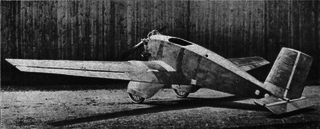
The Albatros L 65 was a German two-seat reconnaissance fighter biplane first flown in 1925.

The Albatros B.I, was a German military reconnaissance aircraft designed in 1913 and which saw service during World War I.

The Albatros C.VII was a military reconnaissance aircraft designed and produced by the German aircraft manufacturer Albatros Flugzeugwerke. It was a revised and re-engined development of the Albatros C.V, which had proved disappointing in service.

The Albatros G.III, was a German bomber aircraft development of World War I. It was a large, single-bay biplane of unequal span and unstaggered wings. Power was provided by two Benz Bz.IVa pusher engines installed in nacelles carried between the wings. An unusual feature of the design was that the lower wing was provided with cutouts for the propellers, allowing the engine nacelles to be mounted further forward than would have been otherwise possible. Few were built, these seeing service mostly on the Macedonian Front in 1917.
The Albatros L 58 was a German airliner of the 1920s. It was a single-engine cantilever monoplane which accommodated the pilot in an open cockpit at the top of the fuselage, and seated five-six passengers within it.

The Albatros L 59 was a single-seat German utility aircraft of the 1920s. It was a single-engine low-wing cantilever monoplane with large, spatted wide track undercarriage attached, unusually for the time not to the fuselage but to the wing roots. The whole aircraft was covered in 3-ply.
The Albatros L 60 was a two-seat German utility aircraft of the 1920s developed from the Albatros L 59. It was a single-engine low-wing cantilever monoplane with large, spatted undercarriage.

The Albatros L 68 Alauda was a two-seat German trainer aircraft of the 1920s. It was a single-engine biplane of conventional configuration that seated the pilot and instructor in tandem, open cockpits. The wings were of unequal span and had a pronounced stagger.

The Albatros L 69 was a two-seat German parasol monoplane racing and training aircraft of 1925. It was a single-engine parasol-wing monoplane of conventional configuration that seated the pilot and passenger in tandem, open cockpits. It was advertised as a trainer, however contemporary reports dismissed this due to the difficulty in accessing the front cockpit, and the designers' focus on performance.

The Albatros L 72 was a German transport aircraft of the 1920s, designed to carry newspapers between German cities for Ullstein Verlag. A single revised example was built for the Hamburger Fremdenblatt.

The Albatros L 73 was a German twin-engined biplane airliner of the 1920s. Of conventional configuration, it featured a streamlined, boat-like fuselage and engine nacelles. All four manufactured aircraft of that type were operated by Deutsche Luft Hansa, one of which crashed near Babekuhl on 28 May 1928.

The Albatros L 75 Ass was a German trainer biplane of the 1920s. Of conventional configuration, it seated the pilot and instructor in separate, open cockpits. The wings were single-bay, equal-span, and had a slight stagger. Production continued after Albatros was absorbed by Focke-Wulf.
The Albatros L 79 Kobold was a single-seat German aerobatic aircraft of the 1920s and 1930s. It was a single-bay biplane with unstaggered, equal-span wings that had a symmetrical airfoil intended to ensure performance during inverted flight.

The Albatros Al 101 was a 1930s German trainer aircraft. It was a parasol-wing monoplane of conventional configuration, and seated the pilot and instructor in separate, open cockpits.

The Fokker D.II was a German fighter biplane of World War I. It was a single-seat fighter aircraft developed before the Fokker D.I. It was based on the M.17 prototype, with single-bay unstaggered wings and a larger fuselage and shorter span than production D.IIs. Using a 75 kW (100 hp) Oberursel U.I, the D.II was underpowered, though the single 7.92 mm (.312 in) lMG 08 machine gun was normal for 1916. The German Army purchased 177.

The Heinkel HD 39 was a special-purpose cargo aircraft developed in Germany in the 1920s to distribute the Berlin newspaper B.Z.. It was a conventional single-bay biplane with staggered wings of equal span, and a fuselage that nearly filled the interplane gap. The pilot sat in an open cockpit, and the undercarriage was of fixed, tailskid type with divided main units. The sole example of the type was built after Ernst Heinkel found out, by chance, that B.Z. required such an aircraft and had ordered two machines from Albatros. Heinkel convinced publisher Ullstein-Verlag to purchase a third aircraft from his firm.

The Albatros B.III,, was a German World War I reconnaissance biplane, built by Albatros Flugzeugwerke as the Albatros LDD.

The Albatros C.IV,. was a German military reconnaissance aircraft built in the autumn of 1915 by Albatros Flugzeugwerke. It was a single-engined biplane, and was based on the Albatros C.III, with which it shared many parts. It was eventually abandoned, in favour of the C.V.

The Albatros L102 / Albatros Al 102, was a German trainer aircraft of the 1930s. It was a parasol-wing landplane, seating the student pilot and instructor in separate, open cockpits. A biplane floatplane version was also built as the Al 102W, with strut-braced lower wings.
The Albatros L 103 / Albatros Al 103 was a German experimental aircraft of the 1930s. It was a parasol-wing landplane of conventional configuration, seating the pilot and flight test observer in separate, open cockpits. The Al 103 was used to test variations in sweepback, dihedral and tailplane area.
















